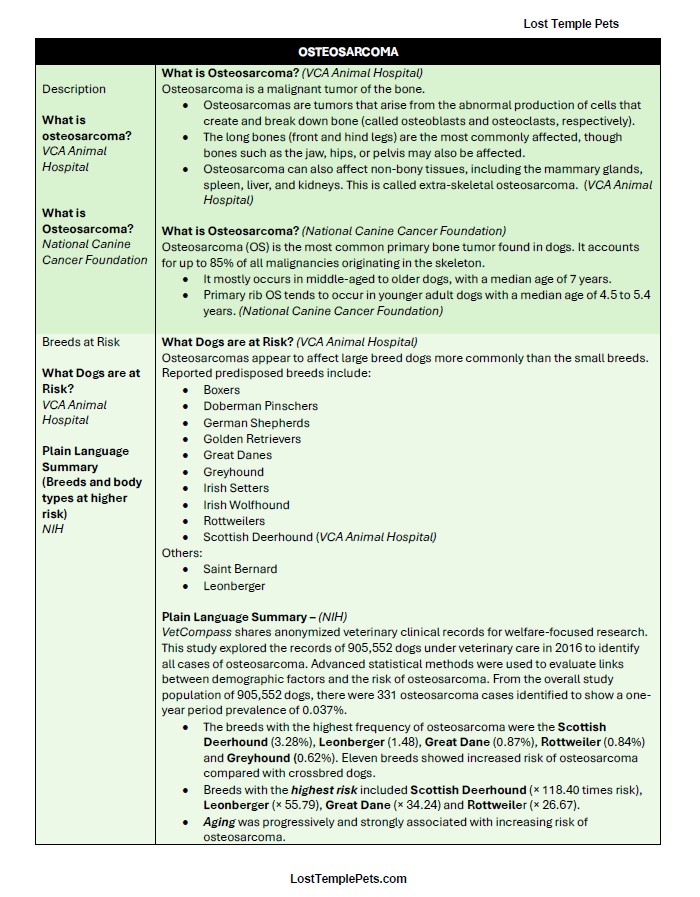Canine Osteosarcoma
(Bone Cancer) & Breeds at Risk
Research, Resources & Education
This website is based on research and is NOT created to diagnose your pet.
Each animal is an individual and may exhibit symptoms in a different way.
It is advised that you ALWAYS CHECK WITH YOUR VETERINARIAN for a proper diagnosis and treatment plan.
Please visit Lost Temple Fitness & Cancer for more information of cancer in humans including
What is Cancer and Treatments.
Table of Contents
Canine Osteosarcoma
Osteosarcoma is a cancerous bone tumor that arises from abnormal bone cell production and can occur in various bones and non-bony tissues.
Symptoms include Lameness, Swelling, Neurologic Signs such as Seizures and Breathing Difficulties.
This tumor commonly affects dogs, particularly middle-aged and older ones of aproximately 7 years of age. Primary rib osteosarcoma is more likely to happen in younger adult dogs.
Treatments include Amputation, Limb-sparing Surgery and Steriotactic Radiation
What Dogs are at Risk?
Some Dogs that are at Risk due to Genetic Predisposition

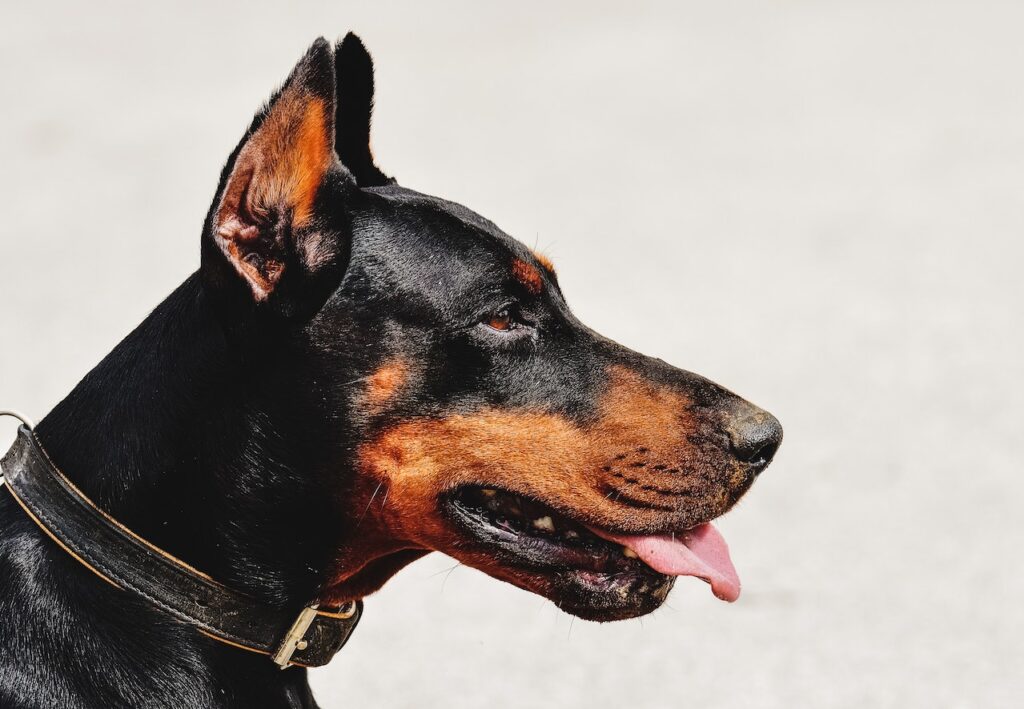

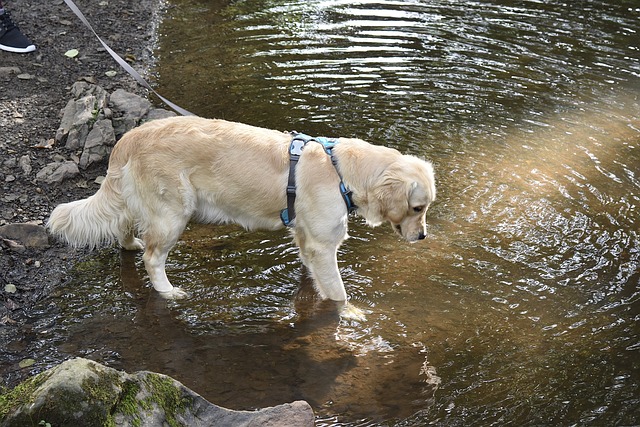
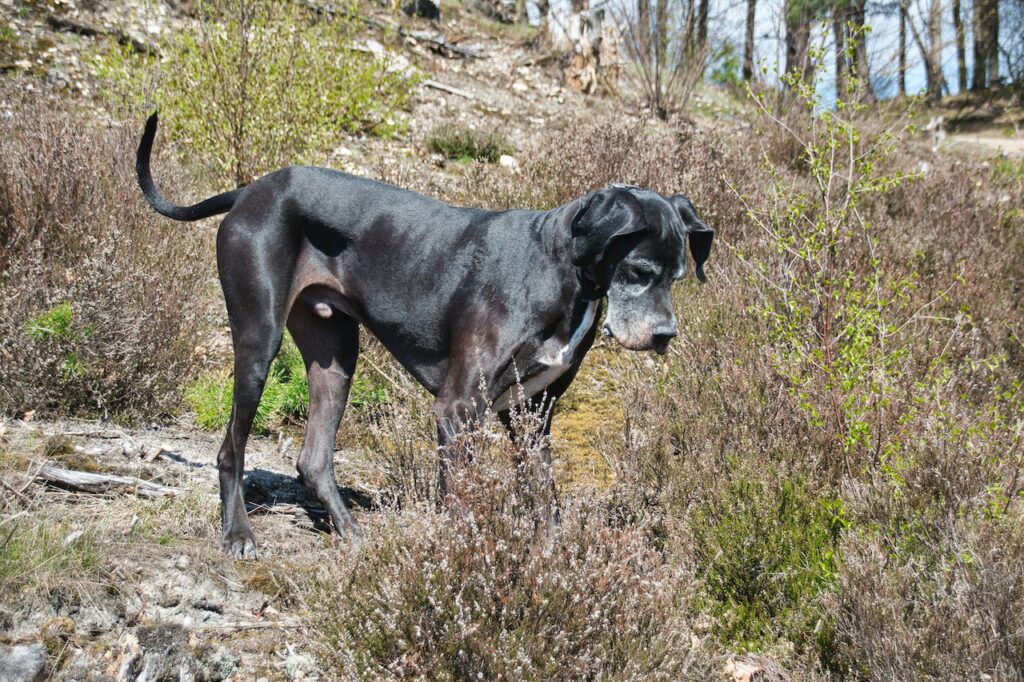
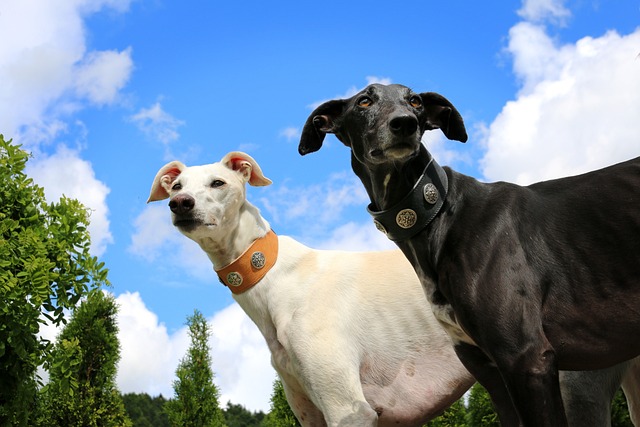

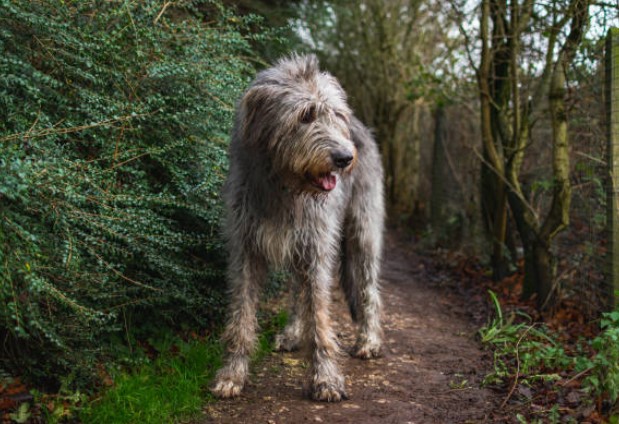
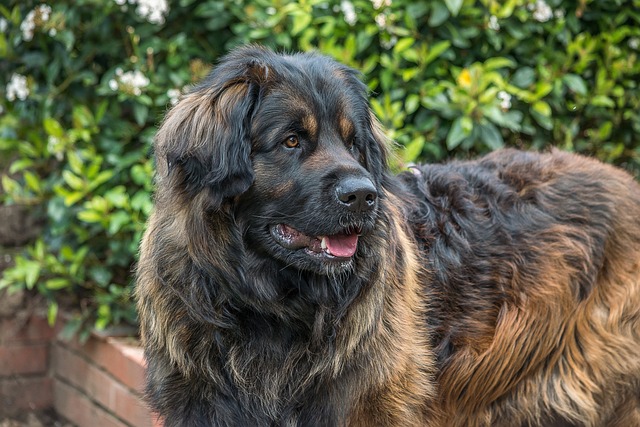

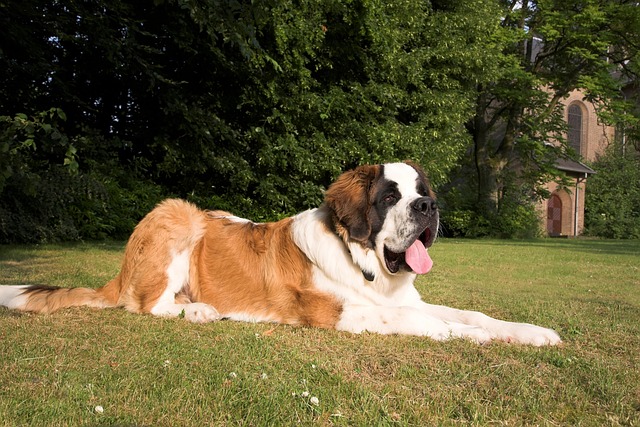
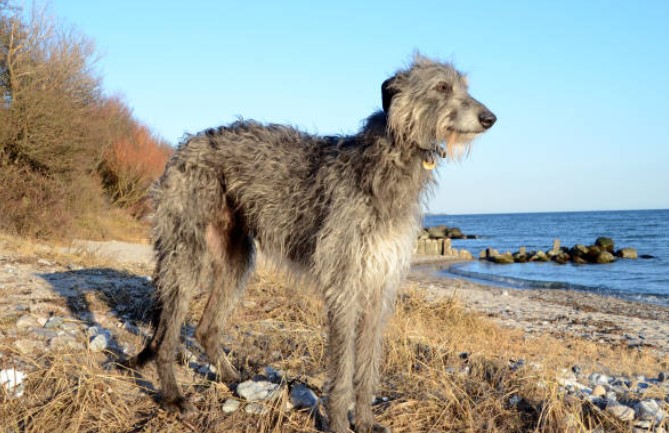
Plain Language Summary (Breeds and body types at higher risk) - NIH
Plain Language Summary – Breeds and body types at higher risk (NIH)
VetCompass shares anonymized veterinary clinical records for welfare-focused research. This study explored the records of 905,552 dogs under veterinary care in 2016 to identify all cases of osteosarcoma. Advanced statistical methods were used to evaluate links between demographic factors and the risk of osteosarcoma. From the overall study population of 905,552 dogs, there were 331 osteosarcoma cases identified to show a one-year period prevalence of 0.037%.
- The breeds with the highest frequency of osteosarcoma were the Scottish Deerhound (3.28%), Leonberger (1.48), Great Dane (0.87%), Rottweiler (0.84%) and Greyhound (62%). Eleven breeds showed increased risk of osteosarcoma compared with crossbred dogs.
- Breeds with the highest risk included Scottish Deerhound (× 40 times risk), Leonberger (× 55.79), Great Dane (× 34.24) and Rottweiler (× 26.67).
- Aging was progressively and strongly associated with increasing risk of osteosarcoma.
- Dogs weighing heavier that the average for their breed had 1.65 times the risk than animals weighing below the breed average.
- Insured dogs had 1.71 times the risk of being diagnosed with osteosarcoma compared with uninsured dogs which may indicate higher levels of healthcare given to insured dogs compared to uninsured dogs.
- Chondrodystrophic (short-legged) breeds had 0.10 times the risk of osteosarcoma compared with non-chondrodystrophic breeds.
- Compared with breeds with mesocephalic (average length) skull conformation, breeds with dolichocephalic (long) skull conformation (× 72) had increased odds of osteosarcoma while breeds with brachycephalic (short) skull conformation showed reduced risk (× 0.50).
- This study cements the concept that breed, bodyweight and longer leg or longer skull length all predispose to osteosarcoma in dogs. With this awareness, veterinarians can update their clinical suspicion and judgement, breeders can select towards lower-risk animals, and researchers can define more useful study populations for better research. (NIH)
What is Osteosarcoma?
What is Osteosarcoma? (VCA Animal Hospital)
Osteosarcoma is a malignant tumor of the bone.
- Osteosarcomas are tumors that arise from the abnormal production of cells that create and break down bone (called osteoblasts and osteoclasts, respectively).
- The long bones (front and hind legs) are the most commonly affected, though bones such as the jaw, hips, or pelvis may also be affected.
- Osteosarcoma can also affect non-bony tissues, including the mammary glands, spleen, liver, and kidneys. This is called extraskeletal osteosarcoma. (VCA Animal Hospital)
What is Osteosarcoma? (National Canine Cancer Foundation)
What is Osteosarcoma? (National Canine Cancer Foundation)
Osteosarcoma (OS) is the most common primary bone tumor found in dogs. It accounts for up to 85% of all malignancies originating in the skeleton.
- It mostly occurs in middle-aged to older dogs, with a median age of 7 years.
- Primary rib OS tends to occur in younger adult dogs with a median age of 4.5 to 5.4 years. (National Canine Cancer Foundation)
Osteosarcoma Videos
YouTube Videos that help explain Osteosarcoma in Dogs
Disclaimer:
This is for research only and Lost Temple Pets does not endorse any video presented on this website.
It is advised that you ALWAYS CHECK WITH YOUR VETERINARIAN for a proper diagnosis and treatment plan.
Risks - Genetic and Environmental
What causes Canine Osteosarcoma and Genetic factors (National Canine Cancer Foundation)
What causes Canine Osteosarcoma? (National Canine Cancer Foundation)
The exact causes of osteosarcoma are not known.
- Factors like ionizing radiation, chemical carcinogens, foreign bodies, (including metal implants, like internal fixators, bullets, and bone transplants), and pre-existing skeletal anomalies like the site of healed fractures sometimes lead to osteosarcoma.
- It has also been associated with chronic osteomyelitis and in fractures in which no internal repair was used.
- Osteosarcoma has been concurrently seen in dogs with bone infarcts.
- In dogs, injected with plutonium during experimental studies, the occurrence has been found to be rampant.
What are the genetic factors that can induce osteosarcoma tumor growth?
Genetic factors are also believed to induce the development of tumors.
- Dogs with OSA have been found to have aberrations of the p53 tumor suppressor gene.
- In laboratory animals, both DNA viruses (polyomavirus and SV-40 virus) and RNA viruses (type C retroviruses) have been found to trigger osteosarcoma.
- Alterations in several growth factors like cytokine or hormone signaling systems have been documented in the pathogenesis of the disease.
- Greater blood vessel density has been shown to be an indicator of primary Osteosarcoma with metastasis. (National Canine Cancer Foundation)
Etiology and Risk Factors of Osteosarcoma (AKC Canine Health Foundation)
Etiology and Risk Factors of Osteosarcoma
AKC Canine Health Foundation
Etiology and Risk Factors of Osteosarcoma (AKC Canine Health Foundation)
A major component of this disease in dogs, and possibly in people, appears to be genetic (i.e., heritable). Risk is most accurately defined by body mass, although there is a direct correlation with size as well. In dogs, there are clear breed predispositions.
Environmental factors that increase risk for osteosarcoma include rapid growth (therefore “large breed” puppy food has reduced levels of available energy to increase the time needed for these dogs to achieve their full size and mass potential), gender (the risk for males is 20 – 50% greater), and metallic implants to fix fractures.
- Chronic trauma and microscopic fractures have been proposed as risk factors, but this is difficult to prove conclusively.
Spaying or Castrating (AKC Canine Health Foundation)
Spaying or Castrating
There was a study from David Waters group (Cooley et al., 2002), where survey data provided by owners showed an increase in risk to develop osteosarcoma in dogs that were spayed or castrated at an early age.
- The relative risk estimated from this study was as high as 4-fold higher for dogs neutered before one year of age than for intact dogs.
- Glickman’s group published similar data in 1998 based on analysis of cases in the Veterinary Medical Database (Ru et al., 1998). These studies generated significant debate and concern among veterinarians and owners. Nevertheless, the results have not been reproduced consistently in other large population studies (for example, Phillips et al and Scottish Deerhounds).
While these results may have increased some owners’ reluctance to neuter or spay dogs, the possible 3-fold increase in risk of osteosarcoma in females should be placed in context of the 80 – 260-fold reduced risk of mammary cancer by early spaying. (AKC Canine Health Foundation)
Symptoms
Signs & Symptoms of Osteosarcoma in Dogs (Pet Cure Oncology)
Signs & Symptoms of Osteosarcoma in Dogs (Pet Cure Oncology)
The symptoms of osteosarcoma, or bone cancer, in dogs can be subtle. They may include:
- Lameness that doesn’t go away and swelling of the affected bone; these are the most common symptoms when a tumor affects a limb
- Swelling or a mass; this is often the first sign of a tumor in the skull, jaw, or ribs
- Difficulty eating if a tumor affects the jaw
- Neurologic signs, such as seizures or a wobbly gait, with the skull or spinal/vertebral tumors
- Breathing difficulties or lameness with rib tumors
- Loss of appetite and lethargy (Pet Cure Oncology)
Are the Symptoms Different on Different Parts of the Dog’s Body? (National Canine Cancer Foundation)
Are the symptoms different on different parts of the dog’s body? (National Canine Cancer Foundation)
The signs associated with the axial skeletal OS are site dependent. They vary from:
- Localized swelling with or without lameness
- Dysphagia (difficulty in swallowing)
- Exophthalmos (bulging of the eye anteriority out of the orbit)
- Pain on opening of the mouth (caudal mandibular or orbital sites)
- Facial deformity
- Nasal discharge
- Hyperesthesia (is a condition that involves an abnormal increase in sensitivity to stimuli of the senses) ith or without neurological symptoms.
- The pain can cause other problems like:
- Irritability
- Aggression
- Loss of appetite
- Weight loss
- Whimpering
- Sleeplessness
- Reluctance to exercise. (National Canine Cancer Foundation)
Testing and Staging
What Diagnostics are used to Determine Treatment for Osteosarcoma ? (National Canine Cancer Foundation)
What diagnostics are used to determine treatment for osteosarcoma in dogs? (National Canine Cancer Foundation)
Because OS treatment is so dependent on understanding your dog’s exact issues and progression of the bone cancer, your veterinarian may advise several procedures to determine the best treatment plan. These include but aren’t limited to:
- Radiographic projections– The first step is to take lateral and craniocaudal radiographic projections. Special views may be crucial for tumors occurring in sites other than in the appendicular skeletons.
- Rectal exam– A rectal exam is also very important with special attention paid to the genitourinary system to help rule out the presence of a primary tumor.
- Biopsy– A biopsy is also mandatory because, in the initial stages, the tumor cells are not distinctly visible. Another reason could be fungal bone infections that also show symptoms similar to osteosarcoma. Bone biopsy may be performed as an open incisional, closed needle, or trephine biopsy. The advantage of the open technique is that a large sample can be procured which makes histopathological diagnosis more accurate.
- Fine needle cytology– It is very important to understand how far the disease has metastasized. Therefore, fine needle cytology is performed on any enlarged node to determine the extent of the spread of the ailment. Sites of bone metastasis may be detected by a careful orthopedic examination with palpation of long bones and the accessible axial skeleton.
- Thoracic auscultation– Organomegaly (abnormal enlargement of organs) may be detected by abdominal palpation. Thoracic auscultation is important to detect intercurrent cardiopulmonary disorders. Advanced imaging, like (CT, MRI, and PET/CT) may play a role in patient staging and is used to evaluate for pulmonary metastases and for tumor vascularity (low body fat, high blood pressure, and muscle engorgement).
- Radiology– Bone survey radiography has been beneficial in detecting dogs with second skeletal sites of osteosarcoma. A nuclear bone scan can be a useful tool for the detection and localization of bone metastasis in dogs. Any region of osteoblastic activity will be identified by this technique including osteoarthritis and infection. (National Canine Cancer Foundation)
Staging for Canine Osteosarcoma (AKC Canine Health Foundation)
Staging for Canine Osteosarcoma (AKC Canine Health Foundation)
Staging uses the “TNMG” (tumor, node, metastasis, grade) system
- Stage I includes low-grade tumors (G1) without evidence of metastasis
- Stage II includes high-grade tumors (G2) without metastasis
- Stage III includes dogs with metastatic disease
- Substages “a” and “b” reflect intramedullary lesions (T1) and local extramedullary spread (T2), respectively
Most dogs with osteosarcoma are diagnosed in Stage IIb (AKC Canine Health Foundation)
Treatment
Treatment Options for Osteosarcoma in Dogs (Pet Cure Oncology)
Treatment Options for Osteosarcoma in Dogs (Pet Cure Oncology)
Osteosarcoma has a variety of treatments – and each treatment depends on your dog’s individual diagnosis. Bone cancer can be treated in any of the following ways:
- Amputation– Because osteosarcoma tumors are so aggressive, amputating the affected limb followed by chemotherapy to treat metastasis is the most common treatment. While amputation isn’t the right option for all pets, otherwise healthy dogs can function quite well with three legs.
- Limb-sparing surgery—This surgery, in which the tumor is removed and the bone is replaced with another bone (either from your pet or from a bone bank), may be an option depending on the tumor’s location and whether it is relatively small at the time of diagnosis. The complication rate for this type of surgery, particularly infection, is relatively high, however.
- Stereotactic radiation – When surgery isn’t an option due to tumor location, stereotactic radiation (SRS/SRT) can be beneficial. It can also be an alternative to amputation for dogs in which the osteosarcoma hasn’t destroyed a great deal of bone. This advanced, highly accurate type of radiation therapy focuses high doses of radiation to damage and kill osteosarcoma cells. Follow-up chemotherapy is still necessary. Stereotactic radiation has a number of advantages over other treatment types. The main advantage of SRS/SRT is that it delivers high doses of radiation with sub-millimeter precision. A few advantage of SRS/SRT over other types of cancer treatment include:
o Precision – Maximum damage to the tumor and there is minimal damage to healthy nearby tissues. Therefore SRS/SRT affords us the ability to treat tumors that were previously considered untreatable with radiation due to this level of precision.
o Fewer treatments – Fewer treatment sessions compared to conventionally fractionated radiation therapy (CFRT). With stereotactic radiation, patients require only 1-3 sessions total, which means fewer anesthetic events, less risk, and less disruption to your schedule.
o Faster recovery – SRS/SRT offers the potential for a quicker recovery with fewer side effects than other treatments.
Sometimes palliative treatment is recommended. Palliative treatment aims to make your pet more comfortable but doesn’t provide a cure, and can include conventional radiation therapy and drugs to reduce pain. (Pet Cure Oncology)
Osteosarcoma Chemotherapy (National Canine Cancer Foundation)
Osteosarcoma Chemotherapy (National Canine Cancer Foundation)
Chemotherapy begins 2 weeks after surgery.
- The drugs administered are cisplatin, carboplatin, or doxorubicin. The standard protocol is 4 to 6 treatments, 3 weeks apart.
- After the surgery, chemotherapy is recommended to catch any stray cancer cells that may have already traveled through the blood to other areas.
- In the wake of no chemotherapy, there is very little chance that your dog will survive one year after surgery. (National Canine Cancer Foundation)
Prognosis
What is the Survival Rate for Dogs with Osteosarcoma? (National Canine Cancer Foundation)
What is the Survival Rate for Dogs with Osteosarcoma? (National Canine Cancer Foundation)
The prognosis for patients with OSA depends on several factors.
- The average survival in dogs with osteosarcoma treated with surgery and chemotherapy is approximately 1 year.
- The prognosis is very poor for patients below 7 years of age with large tumors in the proximal humerus.
- Recently, a median survival time of 7 months was reported for dogs receiving radiation therapy along with chemotherapy; whereas a combination of surgery and chemotherapy showed more encouraging median survival rates of 235-366 days with up to 28% surviving two years after diagnosis.
- Dogs between 7 and 10 years of age have greater survival rates than younger and older dogs.
In axial osteosarcoma, the medial survival rate is 4-5 months because of the reoccurrence of the disease and complete surgery is not possible because of the location. (National Canine Cancer Foundation)
References
References
AKC Canine Health Foundation – Bone Cancer in Dogs
05/20/2010
National Canine Cancer Foundation – Osteosarcoma Bone Cancer In Dogs
https://wearethecure.org/learn-more-about-canine-cancer/canine-cancer-library/osteosarcoma/
NIH – National Library of Medicine – PMC (PubMed Central)
Dog breeds and conformations predisposed to osteosarcoma in the UK: a VetCompass study
Published online 2023 Jun 27
Dan G. O’Neill, Grace L. Edmunds, Jade Urquhart-Gilmore, David B. Church, Lynda Rutherford,3 Matthew J. Smalley, and Dave C. Brodbelt
Pet Cure Oncology – What You Should Know About Osteosarcoma (Bone Cancer) in Dogs
https://petcureoncology.com/what-you-should-know-about-osteosarcoma-bone-cancer-in-dogs/
VCA Animal Hospital – Osteosarcoma in Dogs
By Krista Williams, BSc, DVM, CCRP; Debbie Stoewen DVM, MSW, RSW, PhD; Christopher Pinard, DVM
Cancer/Breed Chart
| BREED | BRAIN | HEMANGIO- SARCOMA | LYMPHOMA | MAMMARY TUMORS | MAST CELL TUMOR | MELANOMA | NASAL TUMOR | ORAL | OSTEOSARCOMA | PERIANAL/ ANAL SAC | SOFT TISSUE SARCOMA | TRANSITIONAL (TCC) / UROTHELIAL (UC) |
|---|---|---|---|---|---|---|---|---|---|---|---|---|
| Airedale Terrier | Lymphoma | Melanoma | Nasal Tumor | Soft Tissue Sarcoma | TCC or UC | |||||||
| Basset Hound | Hemangiosarcoma | Lymphoma | Nasal Tumor | Soft Tissue Sarcoma | ||||||||
| Bulldog, English | Brain | Lymphoma | Mast Cell Tumor | Perianal/Anal Sac | Soft Tissue Sarcoma | |||||||
| Bullmastiff | Lymphoma | Mast Cell Tumor | Soft Tissue Sarcoma | |||||||||
| St. Bernard | Lymphoma | Osteosarcoma | Soft Tissue Sarcoma | |||||||||
| Golden Retriever | Brain | Hemangiosarcoma | Lymphoma | Mast Cell Tumor | Melanoma | Oral | Osteosarcoma | Perianal/Anal Sac | Soft Tissue Sarcoma | |||
| Labrador Retriever | Hemangiosarcoma | Lymphoma | Mast Cell Tumor | Melanoma | Nasal Tumor | Oral | ||||||
| Scottish Terrier | Brain | Lymphoma | Melanoma | Nasal Tumor | Oral | Soft Tissue Sarcoma | TCC or UC | |||||
| Boxer | Brain (Glioma) | Hemangiosarcoma | Lymphoma | Mammary Tumor | Mast Cell Tumor | Oral | Osteosarcoma | Soft Tissue Sarcoma | ||||
| Beagle | Hemangiosarcoma | Lymphoma | Mast Cell Tumor | Perianal/Anal Sac | TCC or UC | |||||||
| West Highland White Terrier | Lymphoma | |||||||||||
| Chow Chow | Lymphoma | Melanoma | Oral | |||||||||
| Poodle, Standard | Lymphoma | Melanoma | Nasal Tumor | Oral | ||||||||
| Rottweiler | Lymphoma | Oral | Osteosarcoma | |||||||||
| Poodle, Toy | Lymphoma | Mammary Tumor | Melanoma | Nasal Tumor | ||||||||
| Yorkshire Terrier | Lymphoma | Mammary Tumor | ||||||||||
| German Shepherd | Hemangiosarcoma | Lymphoma | Mammary Tumor | Melanoma | Nasal Tumor | Oral | Osteosarcoma | Perianal/Anal Sac | ||||
| Poodle, Miniature | Lymphoma | Mammary Tumor | Melanoma | Nasal Tumor | Oral | |||||||
| Affenpinscher | ||||||||||||
| Afghan Hound | ||||||||||||
| Alaskan Malamute | Perianal/Anal Sac | |||||||||||
| American Eskimo, Toy and Standard | ||||||||||||
| American Foxhound | ||||||||||||
| American Pitt Bull Terrier | Hemangiosarcoma | |||||||||||
| American Staffordshire Terrier | ||||||||||||
| American Water Spaniel | ||||||||||||
| Anatolian Shepherd Dog | ||||||||||||
| Australian Cattle Dog | TCC or UC | |||||||||||
| Australian Shepherd | TCC or UC | |||||||||||
| Australian Terrier | ||||||||||||
| Basenji | ||||||||||||
| Bearded Collie | ||||||||||||
| Beauceron | ||||||||||||
| Bedlington Terrier | ||||||||||||
| Belgian Groenendael | ||||||||||||
| Belgian Malinois | ||||||||||||
| Belgian Tervuren | ||||||||||||
| Bernese Mountain Dog | Hemangiosarcoma | Melanoma | Soft Tissue Sarcoma | |||||||||
| Bichon Frise’ | TCC or UC | |||||||||||
| Black and Tan Coonhound | ||||||||||||
| Black Russian Terrier | ||||||||||||
| Bloodhound | Soft Tissue Sarcoma | |||||||||||
| Boerboel | ||||||||||||
| Border Collie | Brain | TCC or UC | ||||||||||
| Border Terrier | ||||||||||||
| Borzoi | Osteosarcoma | |||||||||||
| Boston Terrier | Brain | Mast Cell Tumor | Melanoma | Soft Tissue Sarcoma | ||||||||
| Bouvier des Flandres | Soft Tissue Sarcoma | |||||||||||
| Briard | ||||||||||||
| Brussels Griffon | ||||||||||||
| Bull Terrier | Mast Cell Tumor | Melanoma | ||||||||||
| Bull Terrier, Miniature | Mast Cell Tumor | Melanoma | ||||||||||
| Cairn Terrier | ||||||||||||
| Canaan Dog | ||||||||||||
| Cane Corso (Italian Mastiff) | ||||||||||||
| Caucasian Shepherd | ||||||||||||
| Cavalier King Charles Spaniel | Perianal/Anal Sac | |||||||||||
| Chesapeake Bay Retriever | Melanoma | |||||||||||
| Chinese Crested | ||||||||||||
| Chinese Shar-Pei | Mast Cell Tumor | Soft Tissue Sarcoma | TCC or UC | |||||||||
| Clumber Spaniel | ||||||||||||
| Curly Coated Retriever | ||||||||||||
| Dalmation | Hemangiosarcoma | |||||||||||
| Dandie Dinmont Terrier | ||||||||||||
| Dogo Argentino | ||||||||||||
| Dogue de Bordeaux | ||||||||||||
| English Foxhound | ||||||||||||
| English Toy Spaniel AKA King Charles Spaniel | ||||||||||||
| Field Spaniel | ||||||||||||
| Finnish Spitz | ||||||||||||
| Flat-Coated Retriever | Hemangiosarcoma | |||||||||||
| Fox Terrier, Smooth | Mast Cell Tumor | |||||||||||
| Fox Terrier, Toy | Mast Cell Tumor | |||||||||||
| Fox Terrier, Wire | TCC or UC | |||||||||||
| French Bulldog | ||||||||||||
| German Pinscher | ||||||||||||
| German Wirehaired Pointer | ||||||||||||
| Glen of Imaal Terrier | ||||||||||||
| Great Dane | Brain | Osteosarcoma | Soft Tissue Sarcoma | |||||||||
| Great Pyrenees | ||||||||||||
| Greater Swiss Mountain Dog | ||||||||||||
| Greyhound | Brain (Meningioma) | Hemangiosarcoma | Osteosarcoma | Soft Tissue Sarcoma | ||||||||
| Harrier | ||||||||||||
| Havanese | ||||||||||||
| Ibizan Hound | ||||||||||||
| Irish Terrier | ||||||||||||
| Irish Water Spaniel | ||||||||||||
| Irish Wolfhound | Osteosarcoma | |||||||||||
| Italian Greyhound | Brain | Hemangiosarcoma | ||||||||||
| Japanese Chin | ||||||||||||
| Keeshond | Nasal Tumor | |||||||||||
| Kerry Blue Terrier | ||||||||||||
| Komondor | ||||||||||||
| Kuvasz | ||||||||||||
| Lakeland Terrier | ||||||||||||
| Leonberger | Osteosarcoma | |||||||||||
| Lhasa Apso | TCC or UC | |||||||||||
| Lowchen | ||||||||||||
| Manchester Terrier Toy | ||||||||||||
| Manchester Terrier, Standard | ||||||||||||
| Mastiff | Brain | |||||||||||
| Miniature Pincher | ||||||||||||
| Neapolitan Mastiff | ||||||||||||
| Newfoundland | ||||||||||||
| Norfolk Terrier | ||||||||||||
| Norwegian Buhund | ||||||||||||
| Norwegian Elkhound | Brain | Nasal Tumor | ||||||||||
| Norwich Terrier | ||||||||||||
| Nova Scotia Duck Tolling Retriever | ||||||||||||
| Old English Sheepdog | Brain | |||||||||||
| Otterhound | ||||||||||||
| Papillon | ||||||||||||
| Parsons Russell Terrier | TCC or UC | |||||||||||
| Pekingese | Brain | |||||||||||
| Petit Basset Griffon Vendeen (PBGV) | ||||||||||||
| Pharaoh Hound | ||||||||||||
| Plott Hound | ||||||||||||
| Polish Lowland Sheepdog | ||||||||||||
| Pomeranian | ||||||||||||
| Portuguese Water Dog | Brain | Hemangiosarcoma | ||||||||||
| Presa Canario | ||||||||||||
| Pug | Brain | Mast Cell Tumor | Soft Tissue Sarcoma | |||||||||
| Puli | ||||||||||||
| Pyrenean Shepherd | ||||||||||||
| Rhodesian Ridgeback | Mast Cell Tumor | Soft Tissue Sarcoma | ||||||||||
| Saluki | ||||||||||||
| Samoyed | Perianal/Anal Sac | |||||||||||
| Schipperke | ||||||||||||
| Schnauzer, Miniature | Mast Cell Tumor | Melanoma | Perianal/Anal Sac | Soft Tissue Sarcoma | ||||||||
| Schnauzer, Standard | Mast Cell Tumor | Melanoma | Soft Tissue Sarcoma | |||||||||
| Sealyham Terrier | ||||||||||||
| Shiba Inu | ||||||||||||
| Shih Tzu | Brain | |||||||||||
| Siberian Husky | Perianal/Anal Sac | |||||||||||
| Silky Terrier | ||||||||||||
| Skye Terrier | Hemangiosarcoma | |||||||||||
| Soft-Coated Wheaten Terrier | ||||||||||||
| Spinone Italiano | ||||||||||||
| Staffordshire Bull Terrier | Mast Cell Tumor | |||||||||||
| Sussex Spaniel | ||||||||||||
| Swedish Vallhund | ||||||||||||
| Tibetan Mastiff | ||||||||||||
| Tibetan Spaniel | ||||||||||||
| Tibetan Terrier | ||||||||||||
| Tosa | ||||||||||||
| Vizsla | Melanoma | |||||||||||
| Weimaraner | Mast Cell Tumor | |||||||||||
| Welsh Corgi, Cardigan | ||||||||||||
| Welsh Corgi, Pembroke | ||||||||||||
| Welsh Springer Spaniel | ||||||||||||
| Welsh Terrier | ||||||||||||
| Whippet | Hemangiosarcoma | TCC or UC | ||||||||||
| Wirehaired Pointing Griffon | ||||||||||||
| Akita (American) | Oral | |||||||||||
| Collie, Rough / Smooth Coat | Brain (Meningioma) | Nasal Tumor | Oral | TCC or UC | ||||||||
| Gordon Setter | Melanoma | Oral | ||||||||||
| Irish Setter | Melanoma | Oral | Osteosarcoma | Soft Tissue Sarcoma | ||||||||
| Schnauzer, Giant | Mast Cell Tumor | Melanoma | Oral | |||||||||
| Scottish Deerhound | Brain | Melanoma | Oral | Osteosarcoma | TCC or UC | |||||||
| Shetland Sheepdog | Nasal Tumor | Oral | TCC or UC | |||||||||
| Brittany | Mammary Tumor | |||||||||||
| Chihuahua | Mammary Tumor | Melanoma | ||||||||||
| English Cocker Spaniel | Mammary Tumor | |||||||||||
| English Setter | Mammary Tumor | |||||||||||
| English Springer Spaniel | Mammary Tumor | Melanoma | Perianal/Anal Sac | |||||||||
| Maltese | Mammary Tumor | |||||||||||
| Pointer | Hemangiosarcoma | Mammary Tumor | ||||||||||
| Cocker Spaniel (American) | Mammary Tumor | Mast Cell Tumor | Melanoma | Oral | Perianal/Anal Sac | |||||||
| Dachshund | Brain | Mammary Tumor | Mast Cell Tumor | Oral | Perianal/Anal Sac | |||||||
| Doberman Pinscher | Brain | Mammary Tumor | Melanoma | Oral | Osteosarcoma | |||||||
| German Shorthaired Pointer | Mammary Tumor | Nasal Tumor | Oral |
